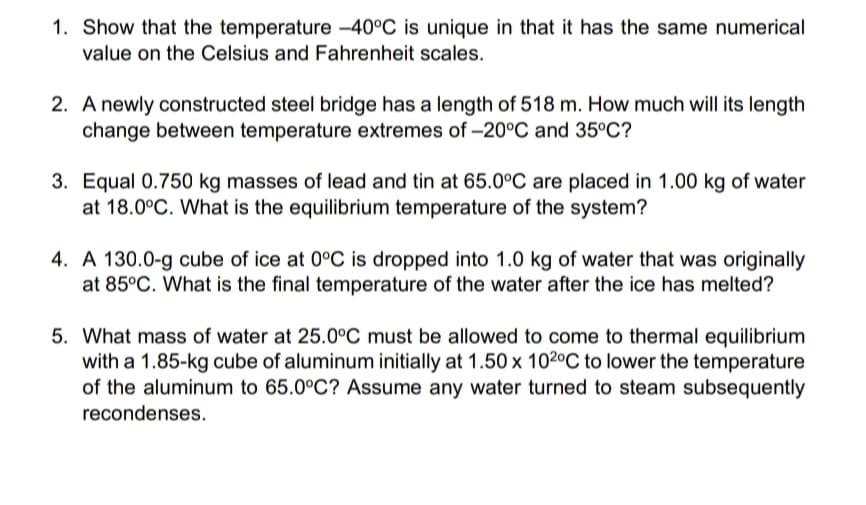College Physics
11th Edition
ISBN:9781305952300
Author:Raymond A. Serway, Chris Vuille
Publisher:Raymond A. Serway, Chris Vuille
Chapter10: Thermal Physics
Section: Chapter Questions
Problem 4P: Death Valley holds the record for the highest recorded temperature in the United States. On July 10,...
Related questions
Question
Energy in Thermal Processes
Pls answer no.2, round the final answer to four decimal places

Transcribed Image Text:1. Show that the temperature -40°C is unique in that it has the same numerical
value on the Celsius and Fahrenheit scales.
2. A newly constructed steel bridge has a length of 518 m. How much will its length
change between temperature extremes of -20°C and 35°C?
3. Equal 0.750 kg masses of lead and tin at 65.0°C are placed in 1.00 kg of water
at 18.0°C. What is the equilibrium temperature of the system?
4. A 130.0-g cube of ice at 0°C is dropped into 1.0 kg of water that was originally
at 85°C. What is the final temperature of the water after the ice has melted?
5. What mass of water at 25.0°C must be allowed to come to thermal equilibrium
with a 1.85-kg cube of aluminum initially at 1.50 x 102°C to lower the temperature
of the aluminum to 65.0°C? Assume any water turned to steam subsequently
recondenses.
Expert Solution
This question has been solved!
Explore an expertly crafted, step-by-step solution for a thorough understanding of key concepts.
Step by step
Solved in 2 steps

Knowledge Booster
Learn more about
Need a deep-dive on the concept behind this application? Look no further. Learn more about this topic, physics and related others by exploring similar questions and additional content below.Recommended textbooks for you

College Physics
Physics
ISBN:
9781305952300
Author:
Raymond A. Serway, Chris Vuille
Publisher:
Cengage Learning

College Physics
Physics
ISBN:
9781285737027
Author:
Raymond A. Serway, Chris Vuille
Publisher:
Cengage Learning

College Physics
Physics
ISBN:
9781938168000
Author:
Paul Peter Urone, Roger Hinrichs
Publisher:
OpenStax College

College Physics
Physics
ISBN:
9781305952300
Author:
Raymond A. Serway, Chris Vuille
Publisher:
Cengage Learning

College Physics
Physics
ISBN:
9781285737027
Author:
Raymond A. Serway, Chris Vuille
Publisher:
Cengage Learning

College Physics
Physics
ISBN:
9781938168000
Author:
Paul Peter Urone, Roger Hinrichs
Publisher:
OpenStax College



Physics for Scientists and Engineers
Physics
ISBN:
9781337553278
Author:
Raymond A. Serway, John W. Jewett
Publisher:
Cengage Learning